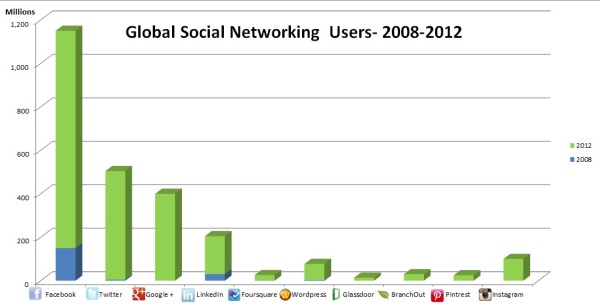Facebook. Twitter. Google+. Pintrest, Instagram, LinkedIn. They all have become mainstream words we use in our everyday conversation. They have penetrated all forms of media including print, TV, radio, video and digital. It would almost seem strange not to hear or see those familiar icons.
For a long time, there seemed to be a perception that only younger people (under 25) were “on” social media. So why then are companies putting so much time, effort and money into using social media platforms for marketing, branding and engagement to a small segment of the population?
Think about it:
- Almost every company, globally, is using a social media channel for branding and engagement
- News channels use Twitter to solicit questions and comments
- Commercials almost always have a “check us out on” Facebook or Twitter as part of their closing
- For reality TV shows… Twitter is a staple
- For mobile, social channels are readily available
- Many web sites enable you use your Facebook, Google+, Twitter or LinkedIn accounts to sign into other accounts such as Pinterest, TripAdvisor, etc.
- Some companies provide the ability use your social accounts such as LinkedIn to apply for jobs.
So it’s not just young people who are using social media channels.
As social media becomes more intertwined with consumer marketing, recreational activities and personal transactions (such as banking), it encourages more people across a wider demographic to use these channels. Mobile technology also offers social media as a core part of their smart phones (including tablets) which make social media channels readily accessible and easy to use on the go.
In the last two years we can see a steady increase across all demographics of people using social media.
No surprise that the highest usage is the under 25 age group. But what we are seeing is the year over year increase of people over 45 using social media. In just one year the 45-54 age group increased 10% shifting to more than half of that demographic now using social media channels. Another interesting observation is an 8% increase of those 65 and over using social media between 2011 and 2012.
The marketing of social media on traditional channels has increased conversion to use these channels and apps to engage and perform transactions. The upsurge in usage for those 55 and over may also be attributed to the way they have determined how the use social media. Research shows that as people get older they tend to take a more thoughtful approach to social media; separating their professional and personal social channels such as Facebook and LinkedIn. Friends and network connections tend to be people they know, instead of casual acquaintances. Increased ability to control privacy settings also make people feel more secure about social networking and sharing information.
As more people start to use social media we also see them expanding and using a variety of different channels. If we think about personal usage on channels such as Facebook we can see in the chart below, there is a broad distribution of users across all demographics. If we look at LinkedIn, we can see more usage for those over 25, the highest among those in the over 55 age bracket. Twitter on the other hand has broader usage for those under 25 and the least amount of usage for those over 55. What they all have in common, are all demographics are using these channels, but at a different capacity, based on what they deem the channels are useful for. What we will start to see is a rise in channels like LinkedIn for those under 25 looking to build their professional profile.
The results show us that social media is being used by all demographics. With technology making it easier to connect we can expect to see a continued rise in the number of “older” people using social media. This is key if you are thinking about possible avenues to market your products, services and jobs.
Consider where you could source your next new hire or business opportunity from using a social media platform.
by Ann Barrett, Director eRecruitment & Social Media Strategy











